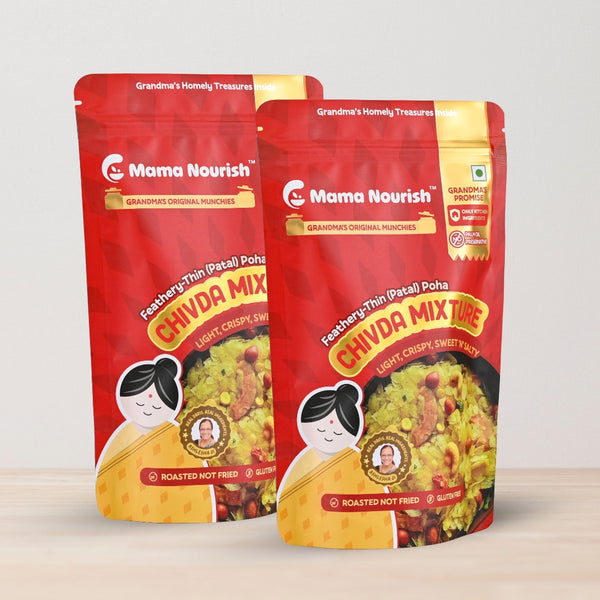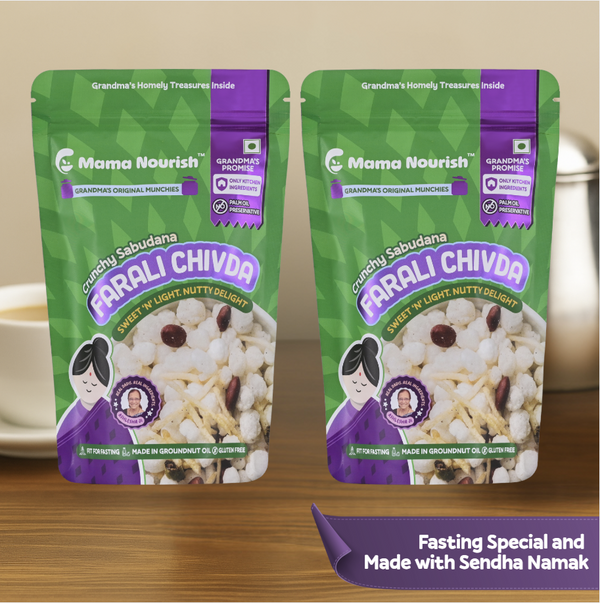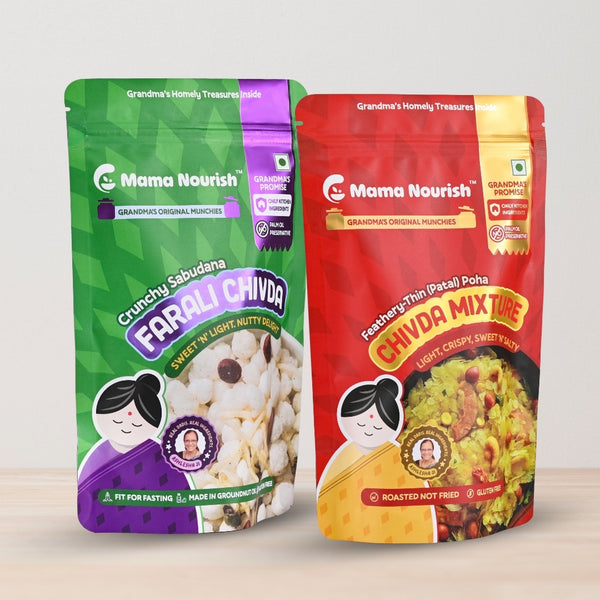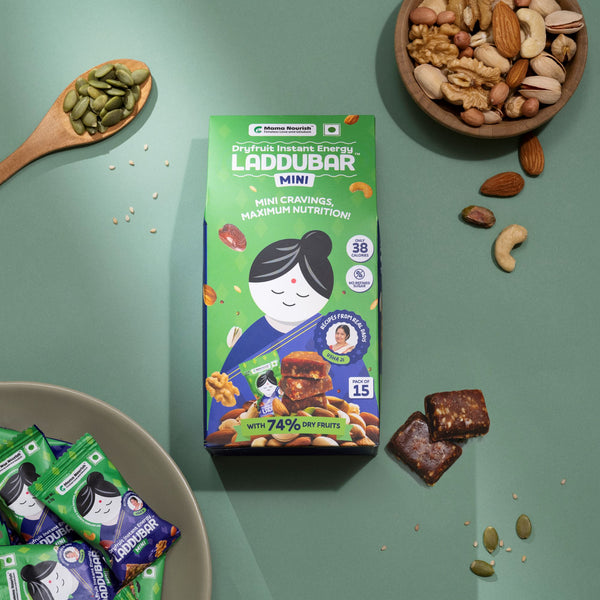
What Took Us Away From Mother’s Nutritious Food? Time to Return?
Did you grab a bite of sandwich or butter toast with your favourite ketchup while setting off to work today? Are packaged foods like breakfast cereals, packaged breads, frozen or ready meals, baked goods, processed cheese, instant noodles, and aerated drinks part of your daily meals? Such processed foods are widely consumed by most urban professionals. Their easy availability and less/no prep time make them an ideal choice while hustling. However, multiple studies have shown that these processed foods cause lifestyle disorders like obesity, heart ailments, diabetes, high blood pressure, fatty liver, etc.
The evolving discussions around unhealthy dietary habits lead us to think about the good old nutritious natural food cooked by our mothers and grandmothers. The Indian traditional dishes were made from locally sourced ingredients combined with timeless knowledge rooted in Ayurveda.
Indian cuisine has a long history dating back to the Indus civilisation. This culinary tradition was influenced by different cultures that thrived in the Indian subcontinent. Hence, an unbroken chain of culinary secrets flowed across the generations via grandmothers and mothers. Today, this chain of sharing recipes has been broken, and our food palette is filled with unhealthy packaged and ultra-processed food items.
But What took us away from grandmothers' nutritious food? How did we depart from this long tradition of a healthy culinary culture? Let’s discuss the reasons for the shift in food habits.
1. Reasons for Moving Away From Traditional Food

1.1.The Time Factor
The advent of Globalisation and liberalisation in India created many job opportunities that demanded long working hours and tight schedules. The entry of multinational corporations, accelerated urbanisation, rapid digitalisation and the rise of the gig economy further reduced the time available for cooking.
While chasing the deadlines, 'time' naturally became the most significant factor in determining food choices. The ready-to-eat or ready-to-cook food items paired well with a fast-paced lifestyle.
Processed foods have become the most convenient choice for working professionals as it is easy to grab a bite even while commuting. But such convenience comes with a hidden danger of increased risk of obesity and other health risks.
1.2. Dual-income Families and Rise in Disposable Income
The rise in disposable income, coupled with a decline in saving culture, led to higher spending on food. One of the reasons for the increase in income levels can be attributed to the rise in dual-income families.
Most of the Indian traditional recipes were transferred from the grandmother's kitchen to the mother's kitchen. But this continuity broke when the new mothers left the kitchen to cubicles.
This shift created a void quickly filled by packaged food items and dining-out tendencies. The unequal gender dynamics in sharing household chores and the pressure of the double burden of household work and professional one made the entry of processed foods inevitable.
1.3. Lack of Adaptation to Suit a Fast-paced Lifestyle

Unfortunately, our traditional recipes failed to adapt to changing lifestyles. Most traditional healthy snacks and recipes are difficult to carry and consume due to a lack of innovation in their form and preservation methods. Their lower shelf life, longer cooking time, and elaborate preparation methods made them an unattractive choice for professionals.
The packaged foods last longer due to the addition of artificial preservatives. They also come in attractive forms like energy bars and bite-sized snacks, making them convenient even while travelling.
1.4. Aggressive Marketing by Multinational Corporations
The entry of multinational corporations into the Indian food sector and their aggressive marketing significantly influenced the food habits of the larger populace. The projection of processed food as a productive choice among working professionals and making them a status symbol primarily affected the urban psyche.
The clamour around high calories in a few bites, better taste due to more elevated sugar and salt content, and aesthetic appearance made them appealing to all ages. Despite knowing the adverse health effects, we all go for a bag of chips while watching our favourite web series!
1.5. Easy Availability and Affordability
It is an undeniable fact that availability and affordability play a crucial role in shaping food habits. The easy availability of packaged foods based on foreign cuisines in retail stores and e-commerce sites made them an ideal choice. The migration to other countries and the spreading of foreign recipes via social media made them an accepted choice among Indians.
The affordability and availability also come with certain red flags like deterioration in quality.
1.6. Lack of Awareness
Even though many people today identify risks associated with junk foods, they have yet to grasp the gravity of the problem. Consumers generally pay attention only to the front of the pack but ignore the details in the back of the food packet, where companies enlist the ingredients, including preservatives. Common preservatives are potassium sorbate, sodium benzoate, potassium sorbate, and butylated hydroxyanisole (BHA)—these hidden ingredients in your diet are known to cause adverse effects on health.
You will be surprised to hear that every single item, from chocolates to energy bars, protein bars, ketchup, noodles, cornflakes, cereals, pasta, and even the sweets from your nearby sweet shop, all are packed with sugar alcohols or hydrogenated oils, or preservatives. So, next time, before you rush to buy your favourite food, don’t forget to check the back of the package!
2. Is it Time to Return?

Our country possesses one of the wealthiest and most profound knowledge-based culinary heritage. Perhaps no other civilisation can claim to be so thoughtful and methodical in forming food habits. The varied geography of India, ranging from deserts, river valleys, mountains, and dense forests, shelters a rich biodiversity in crops, which has led to the development of a nutritious diet focussed on local ingredients and seasonal rhythms. But these nutrient diets are now replaced by junk food.
Earlier, we discussed the reasons that led us to move away from Mother’s recipes, and now let's talk about why it is time to return to Grandma’s kitchen.
2.1 Health benefits

The traditional Indian diet is rich in nutrients and is backed by Ayurveda. Traditional cuisine of India is fine-tuned with the seasonal changes of the Indian subcontinent and contain nutrient-rich millet, cereals, spices, vegetables, milk products, and many seasonal fruits.
The traditional diet emphasises a healthy meal focusing on daily energy requirements, macro and micronutrients, antioxidants and fibre contents. The Indian dietary practices embraced the concept of a 'holistic approach to health' ages before the world started to comprehend health as a state of overall physical and mental well-being and not solely the absence of diseases.
Numerous studies have scientifically proven the health benefits of traditional Indian food.
2.2. Easy to Buy and Higher Shelf Life
Many traditional healthy snacks and other dishes are now available in new forms, like packaged snacks, nutrition bars, protein bars and are readily available online. Such purely organic products also offer a higher shelf life.
The traditional recipes in packaged forms are convenient to carry around and store. Another advantage of traditional recipes is that they offer better taste without compromising health.
2.3. Dealing With the Time Factor
The primary factor that led people away from traditional recipes was the longer cooking time and hassle associated with such recipes. These issues can be solved as such recipes are now available in ready-to-cook-and-eat formats. Now, you don't have to resort to unhealthy junk foods just because of lack of time.
2.4. A Step Towards Sustainability

The Indian traditional food are based on local ingredients like lentils, millets, jaggery, etc. The ingredients like millet are sustainable crops which do not require intensive irrigation or excessive chemical fertilisers; hence, they are more aligned with the aspirations of today’s climate-conscious society.
Most of you might love eating sweet-flavoured food. But Do you know that the sugarcane from which refined sugar comes from is actually a water-intensive crop? The higher water requirement often threatens the water availability in the region.
The ingredients for traditional recipes come from organic sources, making them an environmentally friendly choice, thus paving a path towards sustainability.
2.5. Zero Harmful Food Additives
Our traditional meals and snacks like ladoo, burfi etc., are free of food additives like artificial preservatives, colouring agents, etc. In fact, higher shelf life can be achieved by using non-invasive preservation technologies such as modified atmosphere packaging (MAP) and cold temperature supply chains, which do not require the addition of artificial preservatives
The absence of food additives is very relevant since they are responsible for causing many lifestyle diseases.
According to WHO, lifestyle diseases like heart disease, diabetes, etc, generally referred to as Non-communicable diseases (NCDs). are responsible for the death of 41 million people annually. More than 39% of adults across the globe suffer from obesity, another medical condition generally caused by an unhealthy diet.
3. Final Thoughts
In this blog post, we discussed the main reasons for changing food habits and why we should return to our traditional food.
The Indian food tradition carries the wisdom of innumerable cultures that embrace a healthy way of life. This continuity was lost in modern times due to a fast-paced lifestyle. But convenience came at the cost of health.
Now, it's time to return to our grandmother's kitchen and cherish the wisdom of our traditions. Let's follow the nourishing trails left by our ancestors to ensure overall well-being
Share







